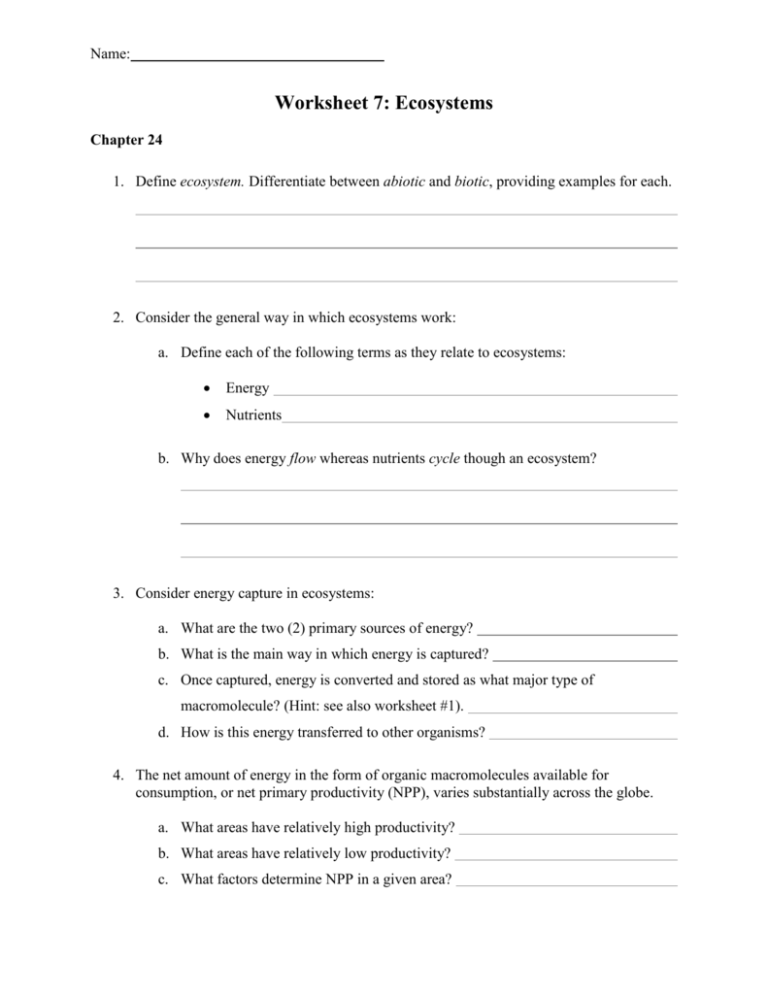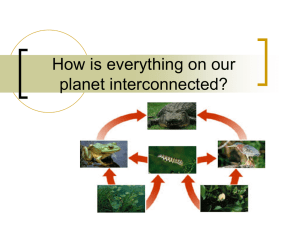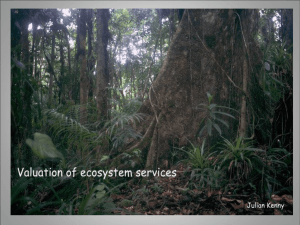WS7-Ecosystems
advertisement

Name: Worksheet 7: Ecosystems Chapter 24 1. Define ecosystem. Differentiate between abiotic and biotic, providing examples for each. 2. Consider the general way in which ecosystems work: a. Define each of the following terms as they relate to ecosystems: Energy Nutrients b. Why does energy flow whereas nutrients cycle though an ecosystem? 3. Consider energy capture in ecosystems: a. What are the two (2) primary sources of energy? b. What is the main way in which energy is captured? c. Once captured, energy is converted and stored as what major type of macromolecule? (Hint: see also worksheet #1). d. How is this energy transferred to other organisms? 4. The net amount of energy in the form of organic macromolecules available for consumption, or net primary productivity (NPP), varies substantially across the globe. a. What areas have relatively high productivity? b. What areas have relatively low productivity? c. What factors determine NPP in a given area? 5. Energy conversion in a community can be represented as an energy pyramid. a. Diagram a simple energy pyramid for a lake community. b. At what trophic level(s) do humans belong in your diagram? Briefly explain. 6. Energy is lost at every level in the energy pyramid where energy is transferred – for example, from primary producers to primary consumers. It is estimated that only 1% of the solar energy striking plants is converted to chemical energy, only 50-90% of gross primary productivity (GPP) becomes net primary productivity (NPP) and only about 10% of the energy available to each trophic level transfers to the next level (as biomass). a. Restate the preceding information in your own words. Be sure to explain how GPP and NPP relate to the percentage of energy transfer from one trophic level to the next. b. Where does the “lost energy” go? Is it correct to say that energy is “lost” in these transfers? If not, what would be a better way of expressing this? c. What is the role of decomposers in ecosystems? 7. Biogeochemical cycles describe the patterns of nutrient transfer between biotic and abiotic components of the ecosystem (i.e. how do nutrients cycle through ecosystems?). Consider the general nutrient cycle (Figure 24.8): a. Where are nutrients stored for long periods of time? b. Where are nutrients that are accessible for producers? c. Where are nutrients that are accessible for consumers and decomposers? 8. Biogeochemical cycles can be categorized based on the form of the chemical. Nutrients that can take on gaseous form may be stored and exchanged via the air. This is known as the atmospheric cycle. Nutrients that cannot be found in gaseous form must be stored and exchanged via land and water only. This is known as the sedimentary cycle. Of these two types of cycles, which would cycle more slowly? Why? 9. Consider the various nutrient cycles. For each nutrient, identify their biological significance, the forms that are usable by organisms, their common reservoirs as well as the processes that drive their cycle: Nutrient Water Carbon Nitrogen Biological Significance Essential for life! Influences primary productivity and decomposition Usable Forms Liquid or vapor Evaporation, condensation, and precipitation Ammonium (NH4+), nitrate (NO3-), amino acids Phosphate (PO43-) Phosphorous Oceans, glaciers, lakes, rivers, and streams Processes Photosynthesis, respiration, volcanic activity Basis of organic molecules! Part of amino and nucleic acids Reservoirs Weathering, leaching, primary productivity, decomposition 10. Humans alter ecosystems through activities that affect net primary productivity. Briefly describe a situation in which humans increase NPP and a situation in which humans decrease NPP. What are the consequences of these ecosystem alterations? 11. Humans also alter nutrient cycles. Briefly discuss how nitrogen and phosphorous cycles are affected by human activities. What are the consequences of these alterations? (Be sure to use Figure 24.15). 12. Consider the ecosystem processes that benefit humans, or ecosystem services. a. What are some examples of ecosystems services? b. What is the estimated value of ecosystem services?











